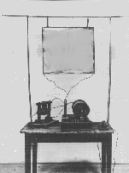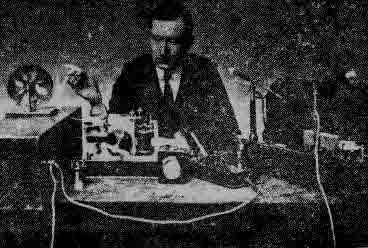Marconi was loosing his monopoly!
Read more articles on ham radio
![]()
Marconi
was loosing his monopoly!
Read more articles on ham radio
| Contribution of Marconi |
Marconi was a ten year old boy when he established a sort of 'Electrical Laboratory' in the year 1885 in the Italian city of Bologna and that too against his father's disapproval! It was a warm day in the year 1895 when this twenty year old boy called Guglielmo Marconi could hear the sound of an airgun fired by his brother Alfonso from behind the hillside near thier home, indicating that Alfonso could copy the Morse Code signals transmitted from a little transmitter built by him. Marconi's homebrewed transmitter based on a circuit designed by the brilliant German physicist Heinrich Hertz was a success. In this experiment. he was able to send messages upto 2 miles.Marconi submitted this improvised prototype of the Hertzian transmitter set to Italy's Minister of Post and Telegraph, but the minister rejected saying "I have no interest in the youngmen's discovery".
 |
This was the first transmitter built by Marconi and used by him on his estate in Italy. The Italian government at first refused to support his work and he was financed by the British Ministry of Posts. (Marconi's mother was British.) |
In the year 1896, Marconi's wireless transmitter and receiver sets were damaged extensively by the customs officials in a border city when he was proceeding towards England. These frustrating events could not stop the young and energetic Marconi. Marconi reassembled his equipment and was able to improve its performance by sending signals upto 4 miles at the Salisbury Plains in England. This equipment was patented on 2nd June 1896.
 Guglielmo Marconi with his homemade wireless equipment |
On December 12, 1901 on a chill, NewFoundland morning, the first proclaimed radio amateur, Guglielmo Marconi, bent intently over his crude receiving instruments and heard the letter "S" (three dots in Morse code) transmitted across the stormy Atlantic Ocean from a station in Cornwell- a distance of about 3,380 kms! Guglielmo Marconi was at a loss to explain why his signals had travelled such a long distance. In this experiment, Marconi was using a wireless transmitter powered by 2,000 volts from a generator driven by a 32 horse-power petrol engine which pumped out 25,000 watts (25 KW) of power at a carrier frequency of about 328 KHz |
His successes apparently convinced his own government and in 1903 he continued his work aboard the royal Italian yacht Carlo Alberto, loaned to him for the purpose of carrying out radio transmission experiments at sea. In 1919 an adventurous Marconi bought a small ship, which he converted into a floating laboratory to conduct his experiments in wireless communication. In this ship, Marconi was conducting his experiments using short wave frequencies and Beam (Directional) Antennae Systems.The experiments carried on by Marconi fascinated radio enthusiasts all over the world and hundreds of private experimental wireless communication stations became operational in America and other parts of the world. As early as 1912, many regular government and commercial wireless stations had been established; they were all on long waves of 200 meters.
Source:
100 Great Lives (Vol 1&2):pages-146,377